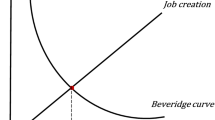Summary
The well known Lucas-Rapping (1969, 1970) U.S. Labour market model has been estimated with a simple disequilibrium estimation method. Neither the wage rate nor the employment level are found to adjust to clear the labour market within the unit time period. The elasticity of labour supply in the short run is found to be high which is consistent with the recent theories of real business cycle. Adjustment in employment towards equilibrium is faster than the adjustment in the wages. The rate of unemployment is satisfactorily explained by the excess supply rate without the need for the lagged unemployment rate. Thus our unemployment equation is superior to the Lucas-Rapping equation based on the equilibrium framework.
Similar content being viewed by others
References
Altonji JG (1982) The intertemporal sustitution model of labour market fluctuations: an empirical analysis. Review of Economic Studies 19:708–724
Bowden RJ (1978) Specification estimation and inference for models of markets in disequilibrium. International Economic Review 19:711–726
Briguglio PL (1984) The specification and estimation of a disequilibrium labour market model. Applied Economics 16:539–554
Chow GC (1977) A reformulation of simulataneous equation models for markets in disequilibrium. Working Paper No. 213, Econometric Research Program, Princeton University
Ito T, Ueda K (1981) Tests of the equilibrium hypothesis in disequilibrium econometrics: an international comparison of credit rationing. International Economic Review 22:691–708
Kmenta J (1986) Elements of econometrics, 2nd ed. MacMillan, New York
Lewis PET, Makepeace HG (1981) The estimation of aggregate demand and supply curves for labour in the U.K. Applied Economics 13:389–398
Levacic R, Rebmann A (1982) Macroeconomics, 2nd ed. MacMillan, London
Lucas RE, Rapping LA (1969) Real wages, employment and inflation. Journal of Political Economy 77:721–754
Lucas RE, Rapping LA (1970) Real wages, employment and inflation. In: Phelps E (ed) Microeconomic foundations of employment and inflation theory. WW Norton and Co, New York
Maddala GS (1983) Limited dependent and qualitative variables in econometrics. Cambridge University Press, New York
Maddala GS (1986) Disequilibrium, self-selection and switching models. In: Griliches Z, Intriligator MD (eds) Handbook of econometrics. North-Holland, Amsterdam
Orsi R (1982) A simultaneous disequilibrium model for Italian export goods. Empirical Economics 7:139–154
Pagan A (1984) Econometric issues in the analysis of regressions with generated regressors. International Economic Review 25:221–248
Quandt RE (1982) Econometric disequilibrium models (with comments). Econometric Reviews 1:1–96
Quandt RE, Rosen H (1985) Unemployment, disequilibrium and the short-run phillips curve: an econometric approach. Journal of Applied Econometrics 1:235–254. Our references in the text are based on the revised mimeographed version of this paper in March 1986
Rees A (1970) On equilibrium in labour markets. Journal of Political Economy 78:306–310
Rosen H, Quandt RE (1978) Estimation of a disequilibrium aggregate labour market. Review of Economics and Statistics 60:371–379
Rudebusch GD (1986) Testing for labour market equilibrium with an exact excessdemand disequilibrium model. Review of Economics and Statistics 68:468–475
Rudebusch GD (1987) The estimation of macroeconomic disequilibrium models with regime classification information. Springer-Verlag, Berlin
Sarantis NC (1981) Employment, labor supply and real wages in market disequilibrium. Journal of Macroeconomics 3:335–354
Author information
Authors and Affiliations
Additional information
I am grateful Professors J. W. Nevile, V. K. Srivastava, the editor of this Journal, Professor Baldev Raj and two referees for their comments on an earlier version of this paper. I wish to thank Kris Corcoran for her excellent research assistance. The research contained in this paper is financed by a grant from the Faculty of Commerce and Economics.
Rights and permissions
About this article
Cite this article
Rao, B.B. A disequilibrium model of real wages, employment and unemployment for the U.S.A. during 1930–1965. Empirical Economics 15, 55–75 (1990). https://doi.org/10.1007/BF01972464
Received:
Revised:
Issue Date:
DOI: https://doi.org/10.1007/BF01972464




